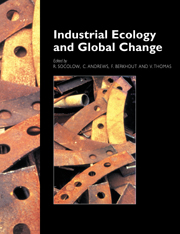Book contents
- Frontmatter
- Contents
- Foreword
- Preface
- Acknowledgments
- Contributors
- OVERVIEW
- PART 1 VULNERABILITY AND ADAPTATION
- PART 2 THE GRAND CYCLES: DISRUPTION AND REPAIR
- 8 Introduction
- 9 Human Impacts on the Carbon and Nitrogen Cycles
- 10 Charting Development Paths: A Multicountry Comparison of Carbon Dioxide Emissions
- 11 Reducing Urban Sources of Methane: An Experiment in Industrial Ecology
- 12 Reducing Carbon Dioxide Emissions in Russia
- 13 Energy Efficiency in China: Past Experience and Future Prospects
- 14 Roles for Biomass Energy in Sustainable Development
- PART 3 TOXICS AND THE ENVIRONMENT
- PART 4 INDUSTRIAL ECOLOGY IN FIRMS
- PART 5 INDUSTRIAL ECOLOGY IN POLICY-MAKING
- END PIECE
- Organizing Committee Members
- Working Groups
- Index
12 - Reducing Carbon Dioxide Emissions in Russia
Published online by Cambridge University Press: 04 August 2010
- Frontmatter
- Contents
- Foreword
- Preface
- Acknowledgments
- Contributors
- OVERVIEW
- PART 1 VULNERABILITY AND ADAPTATION
- PART 2 THE GRAND CYCLES: DISRUPTION AND REPAIR
- 8 Introduction
- 9 Human Impacts on the Carbon and Nitrogen Cycles
- 10 Charting Development Paths: A Multicountry Comparison of Carbon Dioxide Emissions
- 11 Reducing Urban Sources of Methane: An Experiment in Industrial Ecology
- 12 Reducing Carbon Dioxide Emissions in Russia
- 13 Energy Efficiency in China: Past Experience and Future Prospects
- 14 Roles for Biomass Energy in Sustainable Development
- PART 3 TOXICS AND THE ENVIRONMENT
- PART 4 INDUSTRIAL ECOLOGY IN FIRMS
- PART 5 INDUSTRIAL ECOLOGY IN POLICY-MAKING
- END PIECE
- Organizing Committee Members
- Working Groups
- Index
Summary
Abstract
The high energy intensity of the Russian economy has made it one of the world's largest emitters of atmospheric carbon. Macroeconomic models are used to assess the costs of reducing carbon dioxide emissions in Russia. The costs would be high, and would require major structural changes in the Russian economy.
Introduction
Growth in global fossil fuel consumption has led to the degradation of the atmosphere. Two particularly important strategies to counter these negative environmental trends may be identified: (1) a reduction of the energy intensity of the economy (the ratio of total energy consumption to gross national product, or GNP) and (2) a decrease of the share of energy consumption associated with fossil fuels, especially coal.
In the United States, Japan, and several other industrialized countries during the past two decades, energy consumption per unit of GNP has decreased on average by 1% to 2% annually. In the USSR and other countries where industrialization is in its initial phases, however, energy intensity has declined at a much slower rate. By 1990, consumption of primary energy per unit of GNP in the USSR was approximately 2.2 times higher than in the United States and 3 times higher than in Western Europe and Japan.
At least half of the reduction in energy intensity achieved in the United States and Japan can be attributed to structural changes in the economy that did not occur in the USSR (Kononov et al., 1992).
- Type
- Chapter
- Information
- Industrial Ecology and Global Change , pp. 183 - 192Publisher: Cambridge University PressPrint publication year: 1994



